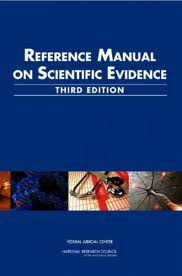Reference Manual on Scientific Evidence: Third Edition–An Indispensable Tool
March 20, 2012
News and Views on Environmental & Toxic Tort Federal and State Legal Issues and Developments
March 20, 2012
With little fanfare, the Federal Judicial Center and the National Research Council of the National Academies issued the Reference Manual on Scientific Evidence: Third Edition, in 2011. Soon after the Supreme Court’s historic 1993 holding in Daubert v. Merrill Dow Pharmaceuticals, Inc., in which federal judges were directed to serve as “gatekeepers,” the Federal Judicial Center published the First Edition of the Reference Manual on Scientific Evidence, which became the leading reference source for federal judges seeking an understanding of difficult issues involving scientific testimony. The Second Edition was published by the Federal Judicial Center in 2000. Considering advances in science, both in terms of how science is treated in the courtroom and in the laboratory, over the last 12 years, a new edition is certainly welcome.
 For the toxic tort practitioner, the Reference Manual on Scientific Evidence is an indispensable reference work. As with previous editions, the Third Edition is organized according to the important scientific and technological disciplines often encountered by federal (or state) judges. It would be difficult to imagine preparing any toxic tort case for trial (or the filing of a Daubert motion) without reviewing, for example, the manual’s chapters on exposure science, epidemiology, toxicology, neuroscience and/or engineering.
For the toxic tort practitioner, the Reference Manual on Scientific Evidence is an indispensable reference work. As with previous editions, the Third Edition is organized according to the important scientific and technological disciplines often encountered by federal (or state) judges. It would be difficult to imagine preparing any toxic tort case for trial (or the filing of a Daubert motion) without reviewing, for example, the manual’s chapters on exposure science, epidemiology, toxicology, neuroscience and/or engineering.
In particular, two critical issues germane to the interpretation of scientific evidence, namely issues of causation and conflict of interest, are highlighted in the new edition’s Preface. Judges are in a less favorable position than scientists to make causation assessments. Scientists have the luxury of delaying their decision while they or others gather more data. Judges, on the other hand, must rule on causation based upon existing information presented to the court. In the final analysis, a judge does not have the option of suspending judgment until more information is available, but must fulfill his gatekeeper role after considering the best available science. The Third Edition seeks to make that judicial task more manageable.
The Preface also discusses the problem of conflict of interest, which is an issue that cuts across most, if not all, scientific disciplines. What is the relationship between conflict and bias? According to the Preface, even though financial conflicts can be identified, the existence of a conflict, even one involving huge sums of money, does not necessarily mean that a given individual will be biased. Thus, having a financial relationship with a commercial entity produces a conflict of interest, but does not inevitably evoke bias. As the Third Edition points out, it is critical that judge and juries consider financial conflicts of interest when assessing scientific testimony, and the threshold for pursuing the possibility of such bias must be low.
I would appreciate comments from practitioners concerning how, if at all, the issuance of the Third Edition has impacted toxic tort trial practice or might do so in the future.